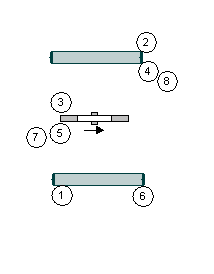
Thommo has a great start-line wait, but we don't use it very often as he is much more motivated if I run with him. There are not a lot of courses where a lead-out gives a significant advantage, and I often see handlers leading out huge distances and then waiting for their dog to catch up before running together. However, Dusty doesn't need the same support at the start-line, and her speed could require strategic positioning on course to give her early warning of the path, so we are back practicing lead-outs. This exercise alternates lead-outs and lead-out pivots.
Lead-out – A handling maneuver where the dog is placed on a wait at the start line and the handler moves to a strategic position prior to starting the course.
Lead-out pivot – A maneuver used to change a dog’s direction off the start line. The handler leads out, faces the direction he initially wants the dog to go, and then calls the dog. As the dog lands, the handler counter-rotates 270° to effect a change of side and change of direction.


